Who Controls the User Experience? AMD’s Carrizo Thoroughly Tested
by Ian Cutress on February 4, 2016 8:00 AM ESTBenchmark Results: CPU Short Form
Here are our results from our CPU tests. A reminder of our systems:
| System Overview | |||||
| µArch | APU | Base / Turbo MHz | Memory | Channel | |
| HP Elitebook 745 G2 | Kaveri | A10 PRO-7350B (19W) | 2100 / 3300 | 8 GB | Dual |
| HP Elitebook 745 G3 | Carrizo | PRO A12-8800B (15W) | 2100 / 3400 | 4 GB | Single |
| Toshiba Satellite E45DW-C4210 |
Carrizo | FX-8800P (15W) | 2100 / 3400 | 8 GB | Single |
| HP Pavilion 17z-g100 |
Carrizo | A10-8700P (15W) | 1800 / 3200 | 8 GB | Single |
| Lenovo Y700 | Carrizo | FX-8800P (35W) | 2100 / 3400 | 16 GB | Single |
Three Dimensional Particle Movement (3DPM)
3DPM is a self-penned benchmark, derived from my academic research years looking at particle movement parallelism. The coding for this tool was rough, but emulates the real world in being non-CompSci trained code for a scientific endeavor. The code is unoptimized, but the test uses OpenMP to move particles around a field using one of six 3D movement algorithms in turn, each of which is found in the academic literature. This test is performed in single thread and multithreaded workloads, and uses purely floating point numbers. The code was written in Visual Studio 2008 in Release mode with all optimizations (including fast math and –Ox) enabled. We take the average of six runs in each instance.
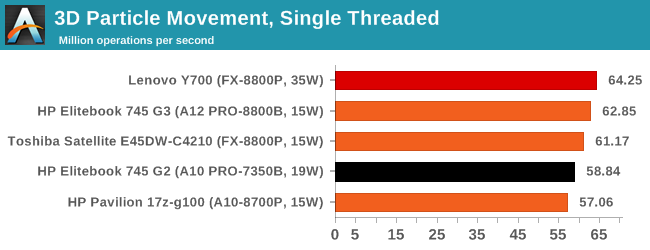
In the single threaded mode, the 35W part is able to boost to a higher frequency, giving it the lead. The interesting element here is the mix of 15W and 19W results, putting the Pavilion with the A10-8700P at the bottom. This comes through in the frequency charts, where the Kaveri was able to boost above 3000 MHz often:
For multithreaded:

The processors line up more as expected, with the 8800P still taking the top spot with Carrizo’s architecture resources showing the ability to scale better.
WinRAR 5.01
WinRAR is a compression tool to reduce file size at the expense of CPU cycles. We use the version that has been a stable part of our benchmark database through 2015, and run the default settings on a 1.52GB directory containing over 2800 files representing a small website with around thirty half-minute videos. We take the average of several runs in this instance.
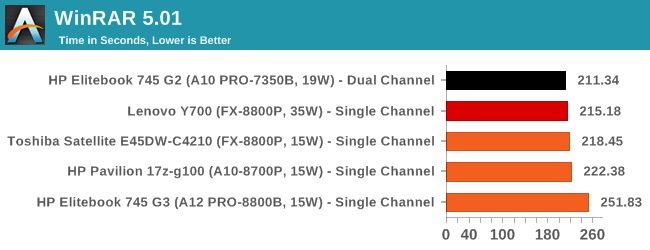
WinRAR is a benchmark which loves DRAM speed, hence why the dual channel Kaveri system wins despite the increased horse power and thermal benefits of the Lenovo Y700. Unfortunately, the single channel design methodology permeates through the OEMs because of the factor of price and upgradability – if a machine is sold with only one module, it can be upgraded later. The other element is that the Y700 design also caters for Carrizo-L as pin compatible, so despite having two modules in there the system will always be limited to single channel. This is, perhaps, a grave error with any situation that is memory limited.
POV-Ray 3.7 beta
POV-Ray is a common ray-tracing tool used to generate realistic looking scenes. We've used POV-Ray in its various guises over the years as a good benchmark for performance, as well as a tool on the march to ray-tracing limited immersive environments. We use the built-in multithreaded benchmark.
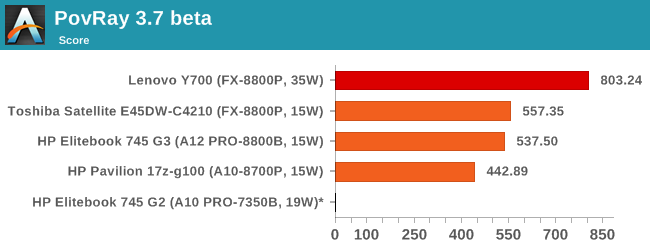
For whatever reason, our script failed to record the score when it came to the Kaveri system and we only realized after the systems were returned. Nonetheless, the capabilities of the other systems shine through, showing that the A10-8700P can seem to have a big frequency discrepancy against the FX-8800P models. In actual fact this can be attributed to the temperature limitations on the Pavilion:
The full threaded nature of POV-Ray means that we’re on the limits of the A10 APU already, but when the system hits 55C or so, it clocks back to 2100 MHz to save a few extra degrees.
If we compare that to the Toshiba:
The Toshiba system also hits a temperature limit, but the barrier is way up at 70C, causing the system to knock back to 64C. The CPU frequency difference between the two does not look that different despite the +25% score in favor of the Toshiba, making it slightly deceptive.
HandBrake
HandBrake is a freeware video conversion tool. We use the tool in to process two different videos - first a 'low quality' two hour video at 640x388 resolution to x264, then a 'high quality' ten minute video at 4320x3840. The low quality video scales at lower performance hardware, whereas the buffers required for high-quality can stretch even the biggest processors. At current, this is a CPU only test.
Unfortunately HandBrake also had issues on a couple of systems – the Lenovo and the Toshiba. All the HP systems gave results, where the HP Pavilion came out on top:


If we compare CPU use, the HP Pavilion is much better at using all of its threads than the Elitebook 745 G3:
7-Zip
7-Zip is a freeware compression/decompression tool that is widely deployed across the world. We run the included benchmark tool using a 50MB library and take the average of a set of fixed-time results.
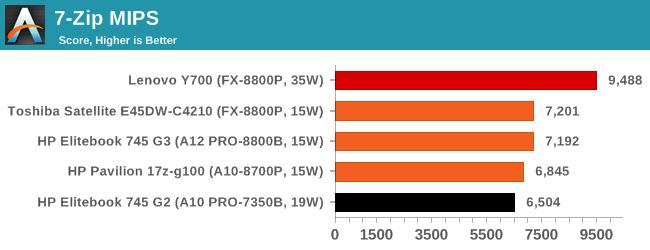
Despite being a purely in-memory benchmark, the G2 shows some inefficiency compared to the Carrizo systems. The slight discrepancy between the 8800 and 8700 shows again, and the Y700 can stretch its legs. Interestingly, the Y700 was able to keep its full CPU frequency on all the time:
Despite the temperature of the CPU moving between 55C and 65C, the system never once reduced its frequency.







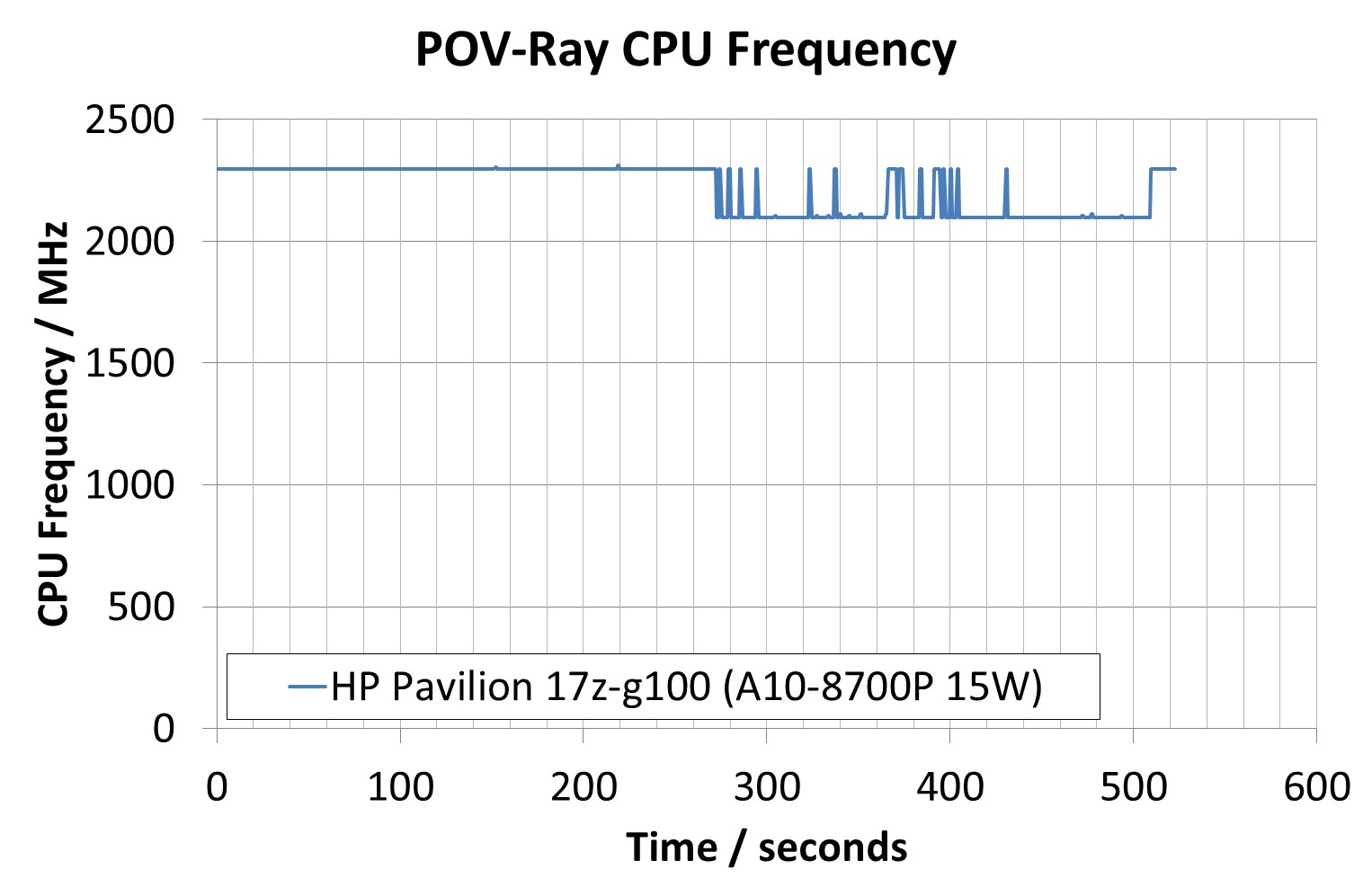
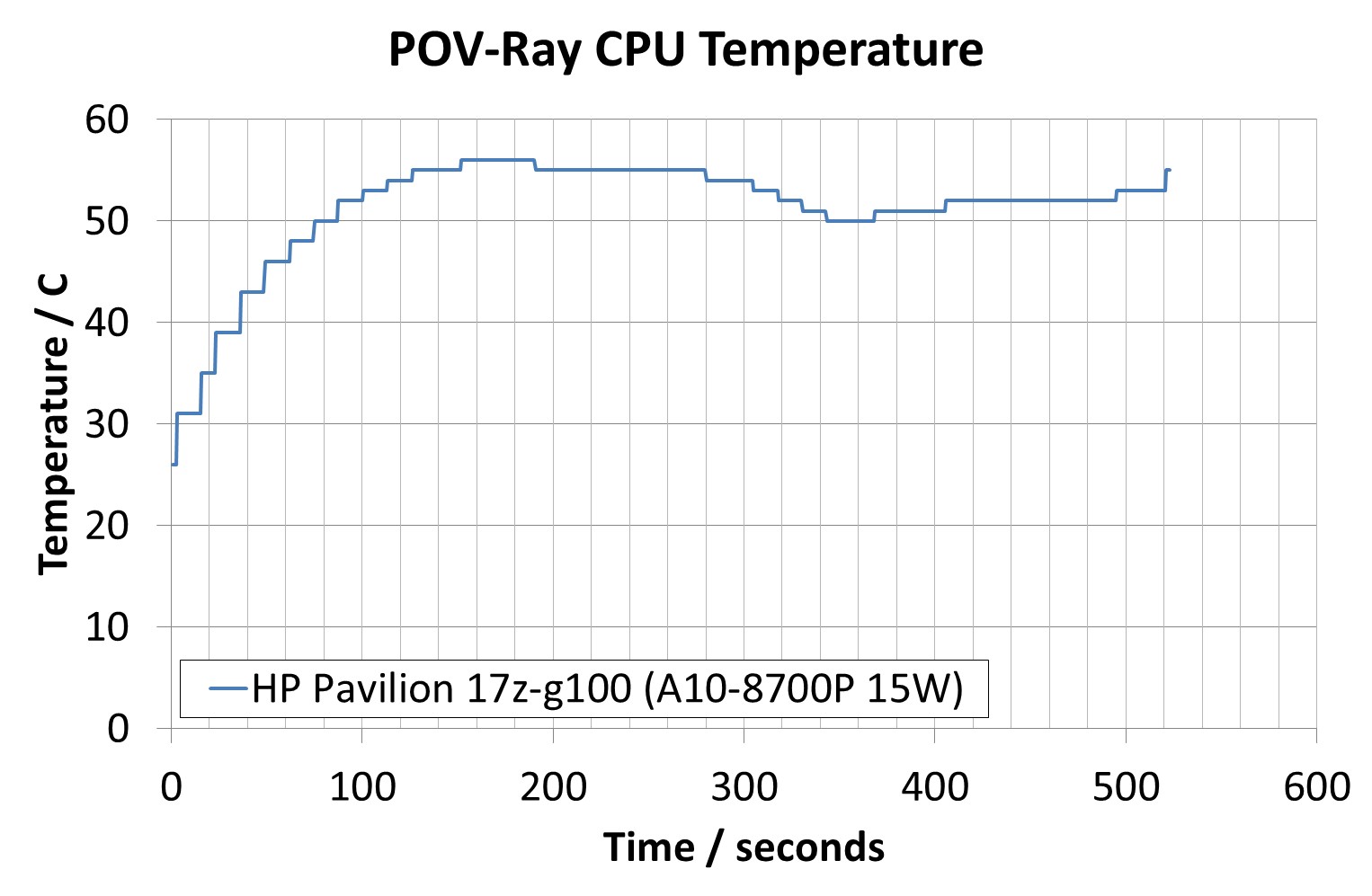


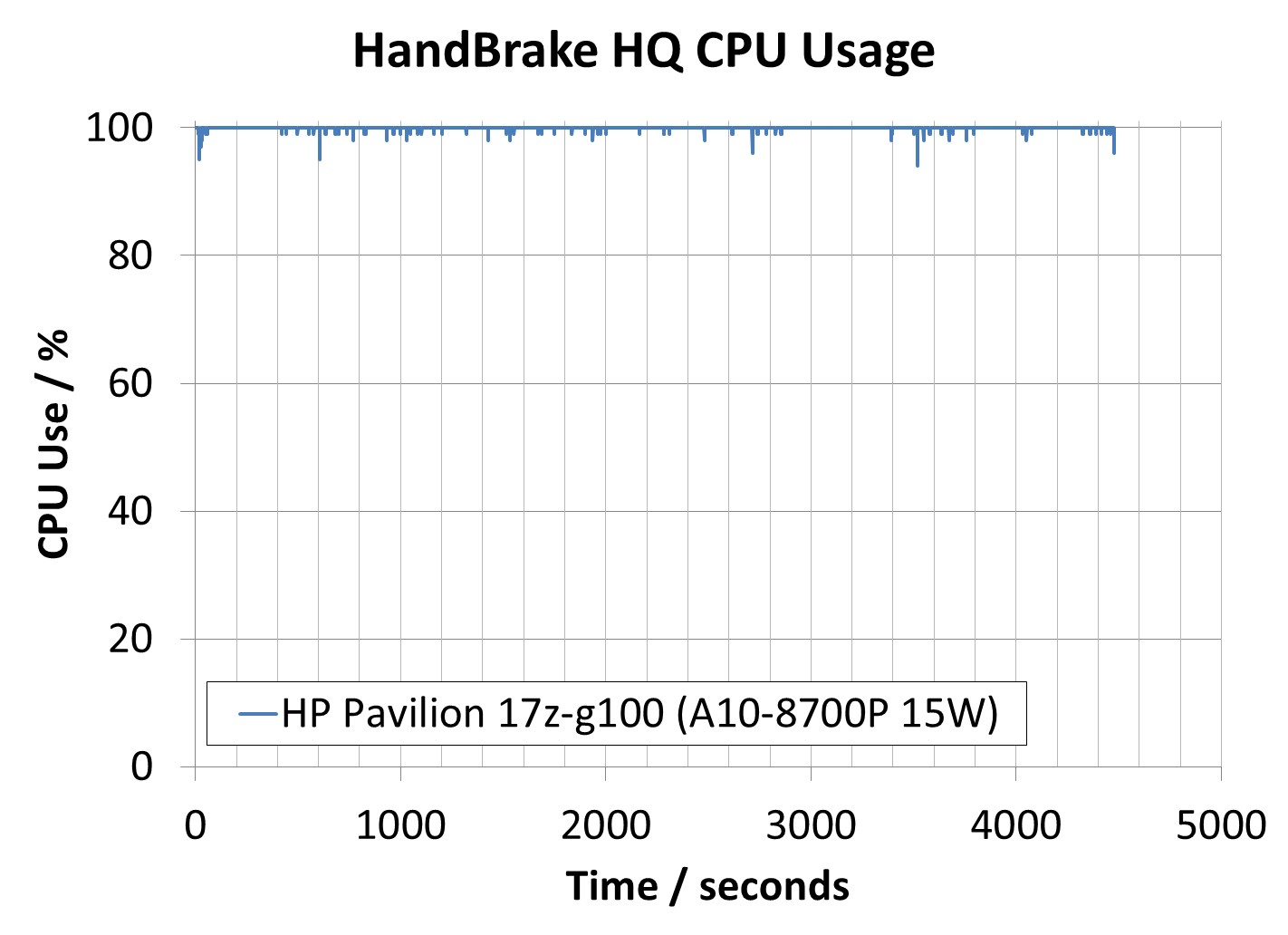

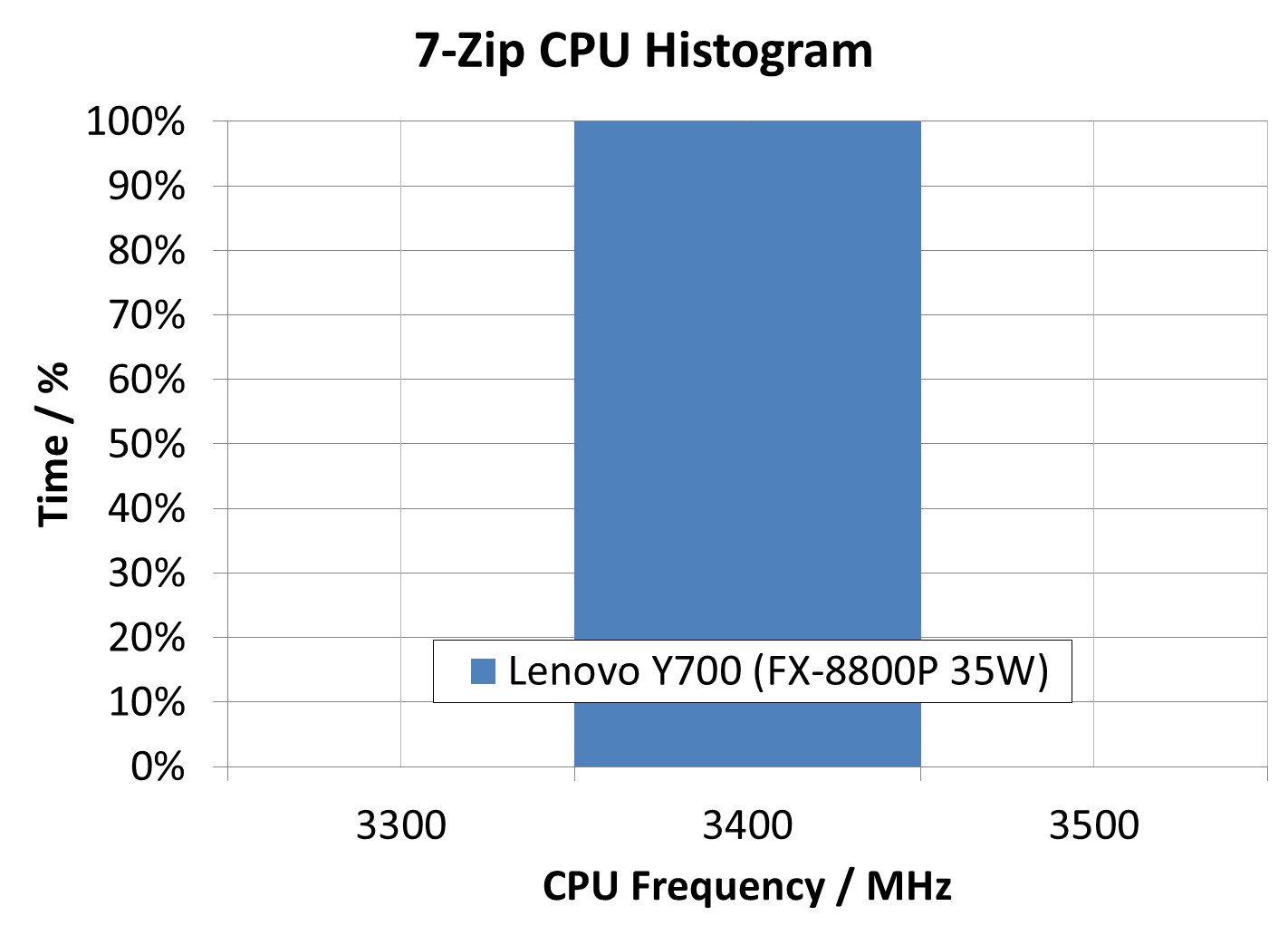









175 Comments
View All Comments
Ian Cutress - Friday, February 5, 2016 - link
It is. It was correct in the table :P fixed!Intel999 - Friday, February 5, 2016 - link
So what I had originally thought would be an advantage for Carrizo, the same motherboard for both Carizzo and Carizzo-L, turned out to screw AMD since OEMs refuse to provide any semblance of sufficient memory on the Carizzo non L chipsets.As for Zen, I can promise you that it will be a failure in laptop configurations if OEMs continue to reign it in with poor configurations such as single channel memory, HDDs and low quality screens.
The only way to get a quality AMD system in this day and age is to go to a custom PC builder and give him the specs you require. Unfortunately, 90% of PC consumers wouldn't know what specs to give the builder and I'm sure Intel has coerced a lot of custom builders to push their CPUs through kickbacks.
reepca - Saturday, February 13, 2016 - link
Could you name a custom PC builder that can build a laptop with Carrizo for me...? Or when you say "PC" do you mean "Desktop" (already gottaone)?junky77 - Friday, February 5, 2016 - link
My Y700 has 4GB of vRAM and GPU-Z show M385XAlso, no talk about DX12?
Bateluer - Friday, February 5, 2016 - link
Any idea when we'll see the X4 845 arrive for desktops?mrdude - Friday, February 5, 2016 - link
Amazing article, Ian! Took the better part of an hour to read it between chores and emails, but it was time well spent :)That said, I feel like one aspect regarding AMD's race-to-the-bottom has been ignored: AMD's own role in it. For decades, and with only a couple of notable exceptions, AMD has marketed itself as the cheaper alternative with 'good enough' performance. Well, unfortunately they've succeeded and this is the result. Carrizo processors on lagging nodes being sold, if only to decrease OEM investments, for dirt cheap and can only just compete with Intel's low end/mid-tier chips. If their engineers are proud of their efforts, then perhaps they need a reality check and take a look at those benchmarks. The APU is so lopsided and bandwidth starved that it should have never made it past the initial stages of design. (Why on earth are they selling 512SPs if they can't feed them? Is the company more worried about chewing up GloFo wafer commitments than designing a balanced design?)
For AMD to command more volume, higher profit margins, and dictate minimum design/spec requirements, AMD also has to start making class-leading products. 'Good enough' should never be uttered within corporate offices else risk being fired. Unfortunately, mediocrity has been the staple of AMD's CPU side for as long as I can remember. CEOs and chief architects have come and gone, and things still haven't changed. After the X2 derivatives of the A64/K8 the company admitted defeat, if not outwardly than certainly tacitly.
I'm not hopeful. Those days are long gone. It's been far too long since AMD has made something that has piqued my, or consumers', interest. They've got nothing but recent failures to point to. Unless Zen comes out and actually beats out Intel's comparable chips in cost, single-threaded, multi-threaded, and power consumption, every person within AMD should admit defeat. The goal is perfection, and personally it seems they still don't understand that.
wow&wow - Monday, February 8, 2016 - link
"they still don't understand that."Because the paychecks are automatically deposited, no feeling about whether having paychecks or not since having them is a given : )
Lolimaster - Friday, February 5, 2016 - link
AMD PLEASE, start selling mobiles devices under your brand.4 of 5 "design wins" shown here are complete sh*t, the Lenovo supposed to be at least decent got serious problems of throttling because they designed the cooling for a 15w TDP.
You're screwing yourself AMD letting OEM's troll you time and time again.
wow&wow - Friday, February 5, 2016 - link
A must read for AMD employees, particularly those who define, approve, or market products, tests needed for those : )thatthing - Friday, February 5, 2016 - link
my Lenovo y700 came with 8gb ram in two 4gb sticks. Sandra and cou z show duel channel. memory test is very similar to my desktop kaveri system with ddr1600. also my r9m385x has 4gb memory. amd's specs list it as 896 shader, which I would agree with as it performs like my 7790 in firestrike